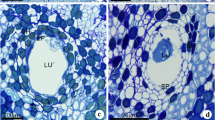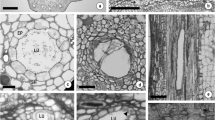Abstract
Phenological observations of mucilage canals inLaminaria angustata in field collected materials indicate that the initials of canals appear first in the spring in the transition zones in fronds of about 20 cm or more. They first appear as scattered dots. These initials are pshed upwards, elongating and branching and a broken mesh system of canals is finally formed as a result of stipe-frondal growth. Later, initials appear abundantly and continuously in the same zone, gradually producing a completely connected anastomosing system of canals.
InLaminaria yezoensis, in one-cell-layered sporophytes, some of the component cells become initials of mucilage glands (fucosan cells), as seen inAlaria andUndaria. This phenomenon is confined to a very short-lived stage. Subsequently, mesh-like mucilage canals are formed as in most other Laminariaceous species as the plants grow.
Anatomically, formation of mucilage canals in the two species takes place through secretory cells produced from periclinal division of the epidermal cells, followed by collapse and reorganization of groups of cells into mucilage canals.
L. yezoensis, having both mucilage canals and mucilage glands in its development, may be classed at the border line betweenUndaria andAlaria which possess only the mucilage gland and other species ofLaminaria which possess the mucilage canal only.
Similar content being viewed by others
References
Grenville, D.J., R.L. Peterson, H.L. Barrales andJ.F. Gerrath. 1982. Structure and development of the secretory cells and duct system inMacrocystis pyrifera (L.) C.A. Agardh. J. Physiol.18: 232–240.
Guignard, L. 1892. Observations sur l'appareil mucifère des Laminariacées. Ann. Sci. Nat. Bot. Biol. Vég. VII15: 1–46.
Kasahara, K. 1967. On the development of the mucillage gland ofUndaria pinnatifida. Bot. Mag. Tokyo80: 279–287 (in Japanese).
— 1973. The development of the mucilage gland of two Japanese species ofAlaria. Bot. Mag. Tokyo86: 169–181.
Kjellman, F.R. andJ.V. Petersen 1885. Om Japans Laminariaceer, in A.E. Nordenskjold, Vega-Exped. Vetenskap. Iakttagelser,4: 259–279 (cited from Miyabe, 1902).
Miyabe, K. 1902. Hokkaido Suisan Chosa Hokoku 3. Konbu saishugyo. Hokkaidocho, Sapporo (in Japanese).
Okamura, K. 1936. Nihon Kaiso Shi. Uchidarokakuho, Tokyo (in Japanese).
Sakai, Y. andT. Funano. 1965. The young sporophytes ofLaminaria from Hokkaido, Japan, I. On young sporophyte ofLaminaria religiosa andL. japonica. Sci. Rep. Hokkaido Fish. Exp. Station3: 39–50 (in Japanese).
—. 1966. The young sporophyte ofLaminaria from Hokkaido, Japan, II. On the young sporophyte ofLaminaria ochotensis. Sci. Rep. Hokkaido Fish. Exp. Station5: 31–35 (in Japanese).
Sauvageau, M. 1918. Recherches sur les Laminaires des côtes de France. Mém. Acad. Sci. Paris56: 1–240.
Yendo, K. 1909. On the mucilage glands ofUndaria. Ann. Bot.23: 613–621.
— 1919. A monograph of the genusAlaria. J. Coll. Sci. Imp. Univ. Tokyo43: 1–145.
Author information
Authors and Affiliations
Rights and permissions
About this article
Cite this article
Kasahara, K. On the mucilage canal and the mucilage gland in two species ofLaminaria (Phaeophyceae, Laminariales). Bot Mag Tokyo 98, 29–40 (1985). https://doi.org/10.1007/BF02488904
Received:
Issue Date:
DOI: https://doi.org/10.1007/BF02488904




